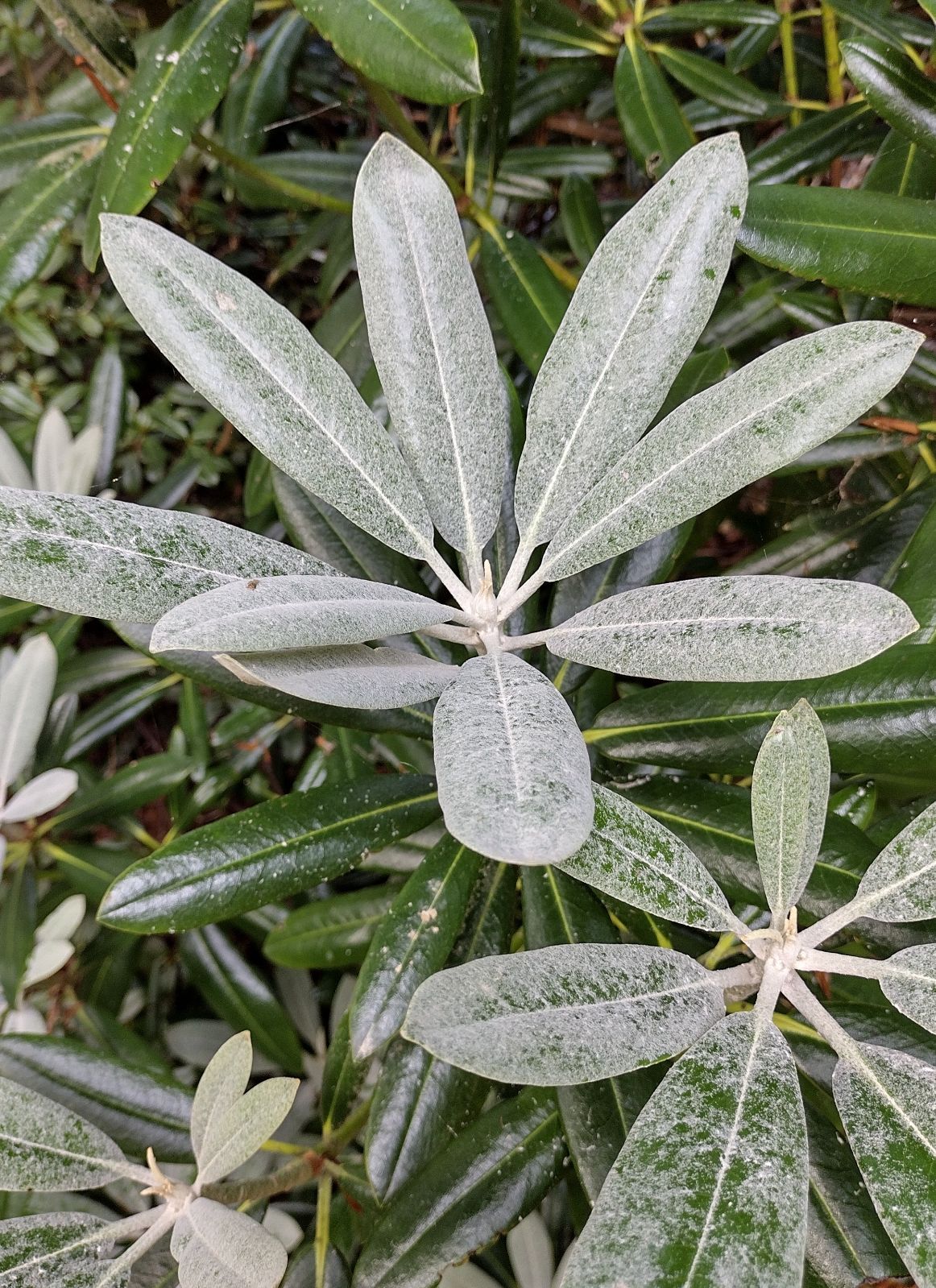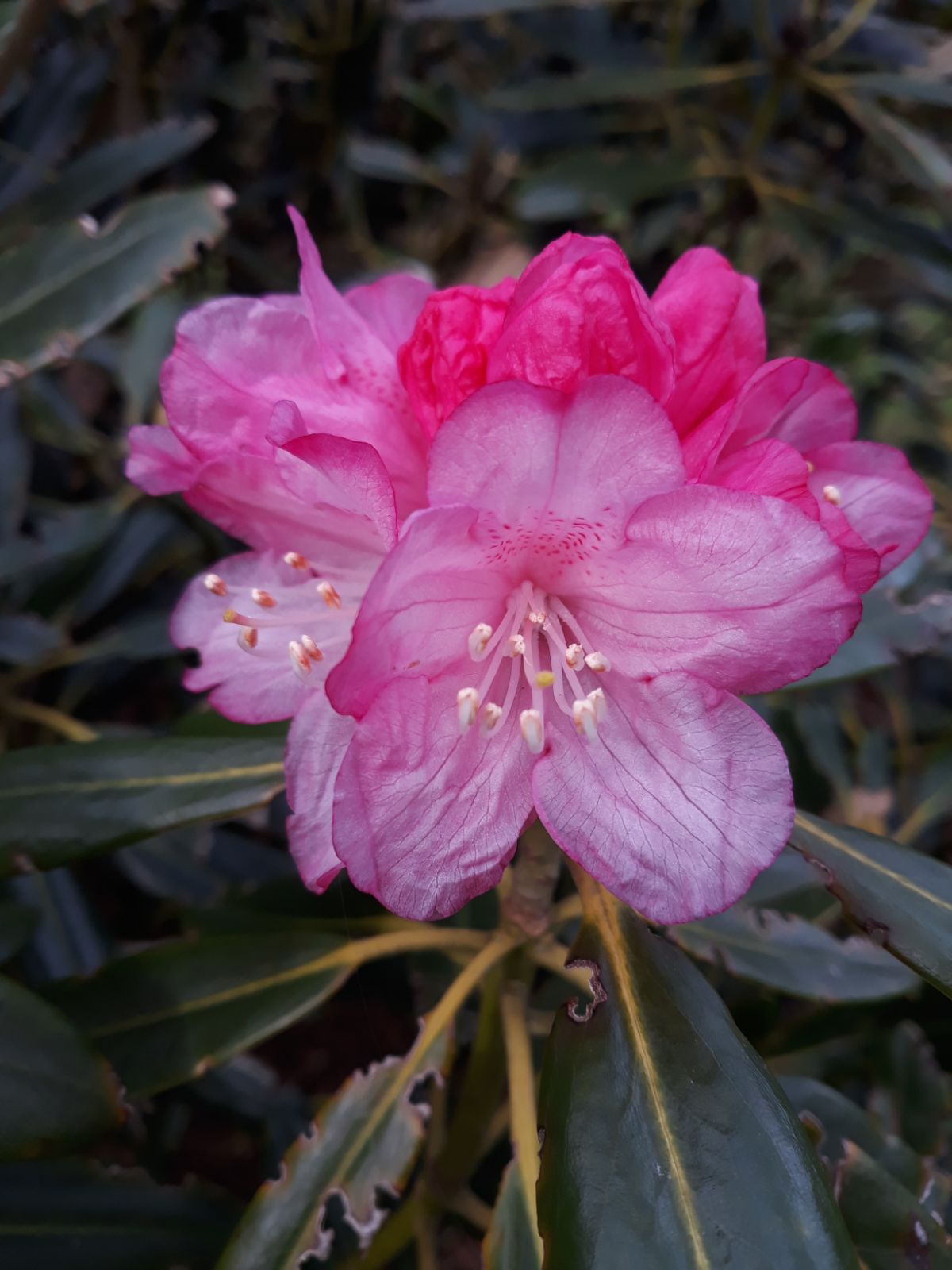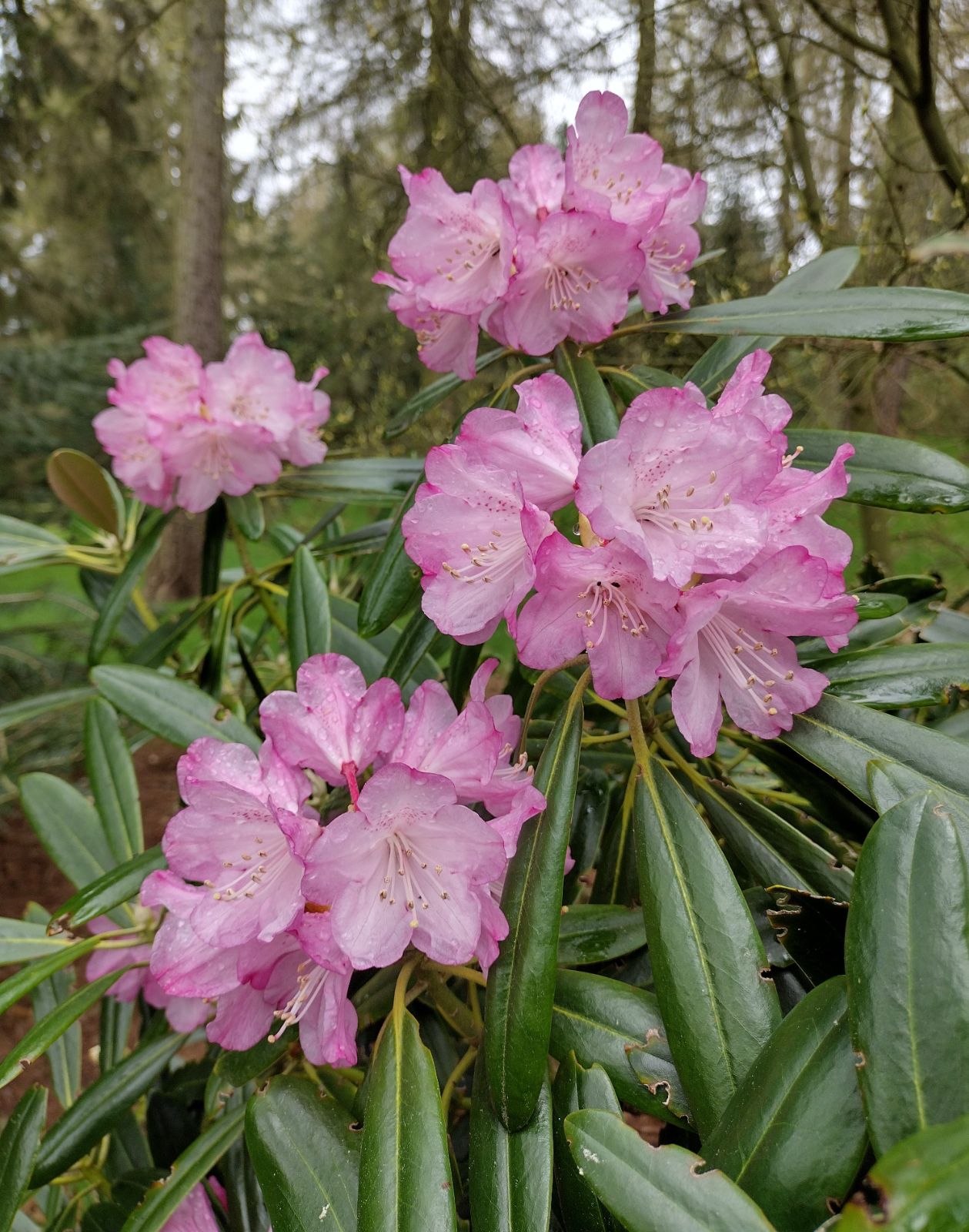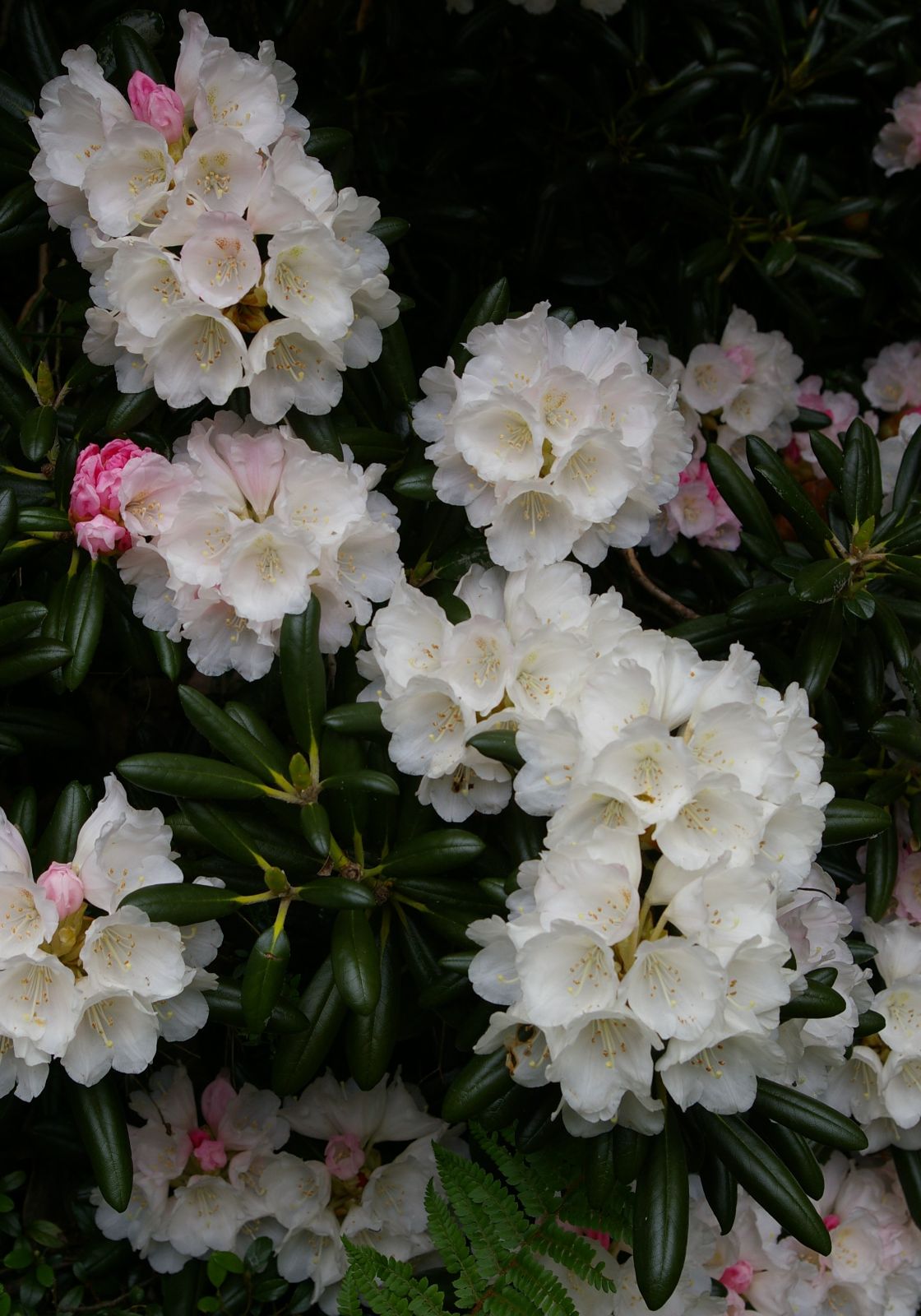Rhododendron degronianum
Sponsor
Kindly sponsored by
Peter Norris, enabling the use of The Rhododendron Handbook 1998
Credits
Article from Bean's Trees and Shrubs Hardy in the British Isles
Recommended citation
'Rhododendron degronianum' from the website Trees and Shrubs Online (treesandshrubsonline.
Genus
- Rhododendron
- Subsect. Pontica
Synonyms
- Rhododendron metternichii, nom. illegit., f. pentamerum Maxim.
- Rhododendron japonicum (Bl.) Schneid. var. pentamerum Hutch.
Infraspecifics
Other taxa in genus
- Menziesia multiflora
- Rhododendron aberconwayi
- Rhododendron acuminatum
- Rhododendron adenogynum
- Rhododendron adenopodum
- Rhododendron adenosum
- Rhododendron aequabile
- Rhododendron afghanicum
- Rhododendron aganniphum
- Rhododendron agastum
- Rhododendron × agastum
- Rhododendron alabamense
- Rhododendron albertsenianum
- Rhododendron albiflorum
- Rhododendron albrechtii
- Rhododendron album
- Rhododendron alticolum
- Rhododendron alutaceum
- Rhododendron amagianum
- Rhododendron ambiguum
- Rhododendron amesiae
- Rhododendron anagalliflorum
- Rhododendron annae
- Rhododendron anthopogon
- Rhododendron anthopogonoides
- Rhododendron anthosphaerum
- Rhododendron anwheiense
- Rhododendron aperantum
- Rhododendron araiophyllum
- Rhododendron arborescens
- Rhododendron arboreum
- Rhododendron arfakianum
- Rhododendron argipeplum
- Rhododendron argyrophyllum
- Rhododendron arizelum
- Rhododendron armitii
- Rhododendron atlanticum
- Rhododendron atropurpureum
- Rhododendron atrovirens
- Rhododendron augustinii
- Rhododendron aureum
- Rhododendron auriculatum
- Rhododendron aurigeranum
- Rhododendron auritum
- Rhododendron austrinum
- Rhododendron baenitzianum
- Rhododendron bagobonum
- Rhododendron baileyi
- Rhododendron bainbridgeanum
- Rhododendron balangense
- Rhododendron balfourianum
- Rhododendron barbatum
- Rhododendron basilicum
- Rhododendron batemanii
- Rhododendron bathyphyllum
- Rhododendron beanianum
- Rhododendron beesianum
- Rhododendron beyerinckianum
- Rhododendron bhutanense
- Rhododendron blackii
- Rhododendron boothii
- Rhododendron brachyanthum
- Rhododendron brachycarpum
- Rhododendron bracteatum
- Rhododendron brevistylum
- Rhododendron brookeanum
- Rhododendron bryophilum
- Rhododendron bureavii
- Rhododendron bureavioides
- Rhododendron burmanicum
- Rhododendron burttii
- Rhododendron buxifolium
- Rhododendron caesium
- Rhododendron calendulaceum
- Rhododendron caliginis
- Rhododendron callimorphum
- Rhododendron calophytum
- Rhododendron calostrotum
- Rhododendron caloxanthum
- Rhododendron calvescens
- Rhododendron camelliiflorum
- Rhododendron campanulatum
- Rhododendron campylocarpum
- Rhododendron campylogynum
- Rhododendron camtschaticum
- Rhododendron canadense
- Rhododendron x candelabrum
- Rhododendron canescens
- Rhododendron capitatum
- Rhododendron carneum
- Rhododendron carolinianum
- Rhododendron carrii
- Rhododendron carringtoniae
- Rhododendron catacosmum
- Rhododendron catawbiense
- Rhododendron caucasicum
- Rhododendron cephalanthum
- Rhododendron cerasinum
- Rhododendron chaetomallum
- Rhododendron chamaethomsonii
- Rhododendron championiae
- Rhododendron charitopes
- Rhododendron chionanthum
- Rhododendron chlorops
- Rhododendron christi
- Rhododendron christianae
- Rhododendron chryseum
- Rhododendron chrysodoron
- Rhododendron ciliatum
- Rhododendron ciliicalyx
- Rhododendron cinnabarinum
- Rhododendron citriniflorum
- Rhododendron clementinae
- Rhododendron coelicum
- Rhododendron coeloneuron
- Rhododendron collettianum
- Rhododendron columbianum
- Rhododendron commonae
- Rhododendron complexum
- Rhododendron concinnum
- Rhododendron coriaceum
- Rhododendron coryanum
- Rhododendron cowanianum
- Rhododendron coxianum
- Rhododendron crassifolium
- Rhododendron crassum
- Rhododendron crinigerum
- Rhododendron cruttwellii
- Rhododendron cuffeanum
- Rhododendron culminicolum
- Rhododendron cumberlandense
- Rhododendron cuneatum
- Rhododendron cyanocarpum
- Rhododendron dalhousiae
- Rhododendron dasypetalum
- Rhododendron dauricum
- Rhododendron davidii
- Rhododendron davidsonianum
- Rhododendron decandrum
- Rhododendron × decipiens
- Rhododendron decorum
- Rhododendron dendricola
- Rhododendron dendrocharis
- Rhododendron denudatum
- Rhododendron desquamatum
- Rhododendron detonsum
- Rhododendron dianthosmum
- Rhododendron diaprepes
- Rhododendron dichroanthum
- Rhododendron dielsianum
- Rhododendron dignabile
- Rhododendron dilatatum
- Rhododendron dimitrium
- Rhododendron diphrocalyx
- Rhododendron discolor
- Rhododendron dryophyllum
- Rhododendron eclecteum
- Rhododendron × edgarianum
- Rhododendron edgeworthii
- Rhododendron elegantulum
- Rhododendron elliottii
- Rhododendron ericoides
- Rhododendron eriocarpum
- Rhododendron eriogynum
- Rhododendron erosum
- Rhododendron × erythrocalyx
- Rhododendron esetulosum
- Rhododendron eudoxum
- Rhododendron eurysiphon
- Rhododendron exasperatum
- Rhododendron excellens
- Rhododendron faberi
- Rhododendron facetum
- Rhododendron falconeri
- Rhododendron fallacinum
- Rhododendron fargesii
- Rhododendron farrerae
- Rhododendron fastigiatum
- Rhododendron faucium
- Rhododendron ferrugineum
- Rhododendron fictolacteum
- Rhododendron flammeum
- Rhododendron flavidum
- Rhododendron fletcherianum
- Rhododendron flinckii
- Rhododendron floccigerum
- Rhododendron floribundum
- Rhododendron flumineum
- Rhododendron formosanum
- Rhododendron formosum
- Rhododendron forrestii
- Rhododendron fortunei
- Rhododendron fragariiflorum
- Rhododendron fulgens
- Rhododendron fulvastrum
- Rhododendron fulvum
- Rhododendron galactinum
- Rhododendron gardenia
- Rhododendron genestierianum
- Rhododendron giulianettii
- Rhododendron glanduliferum
- Rhododendron glaucophyllum
- Rhododendron glischroides
- Rhododendron glischrum
- Rhododendron goodenoughii
- Rhododendron goreri
- Rhododendron gracilentum
- Rhododendron grande
- Rhododendron griersonianum
- Rhododendron griffithianum
- Rhododendron groenlandicum
- Rhododendron grothausii
- Rhododendron gymnocarpum
- Rhododendron habrotrichum
- Rhododendron haematodes
- Rhododendron hanceanum
- Rhododendron haofui
- Rhododendron headfortianum
- Rhododendron hedyosmum
- Rhododendron heftii
- Rhododendron heliolepis
- Rhododendron hellwigii
- Rhododendron hemitrichotum
- Rhododendron hemsleyanum
- Rhododendron herzogii
- Rhododendron hidakanum
- Rhododendron × hillieri
- Rhododendron himantodes
- Rhododendron hippophaeoides
- Rhododendron hirsutum
- Rhododendron hirtipes
- Rhododendron hodgsonii
- Rhododendron hongkongense
- Rhododendron hooglandii
- Rhododendron hookeri
- Rhododendron horlickianum
- Rhododendron houlstonii
- Rhododendron huianum
- Rhododendron hunnewellianum
- Rhododendron hyacinthosmum
- Rhododendron hylaeum
- Rhododendron hyperythrum
- Rhododendron hypoleucum
- Rhododendron imberbe
- Rhododendron impeditum
- Rhododendron imperator
- Rhododendron inconspicuum
- Rhododendron indicum
- Rhododendron inopinum
- Rhododendron insigne
- Rhododendron intranervatum
- Rhododendron intricatum
- Rhododendron irroratum
- Rhododendron japonicum
- Rhododendron jasminiflorum
- Rhododendron javanicum
- Rhododendron johnstoneanum
- Rhododendron kaempferi
- Rhododendron kanehirae
- Rhododendron kawakamii
- Rhododendron keiskei
- Rhododendron keleticum
- Rhododendron kendrickii
- Rhododendron kesangiae
- Rhododendron keysii
- Rhododendron kiusianum
- Rhododendron kiyosumense
- Rhododendron kongboense
- Rhododendron konori
- Rhododendron kyawii
- Rhododendron lacteum
- Rhododendron laetum
- Rhododendron lagopus
- Rhododendron lanatoides
- Rhododendron lanatum
- Rhododendron lanceolatum
- Rhododendron lanigerum
- Rhododendron lapponicum
- Rhododendron latoucheae
- Rhododendron laudandum
- Rhododendron lepidostylum
- Rhododendron lepidotum
- Rhododendron leptanthum
- Rhododendron leptocarpum
- Rhododendron leptothrium
- Rhododendron leucaspis
- Rhododendron leucogigas
- Rhododendron levinei
- Rhododendron lindaueanum
- Rhododendron lindleyi
- Rhododendron lochiae
- Rhododendron longesquamatum
- Rhododendron longiflorum
- Rhododendron longipes
- Rhododendron longistylum
- Rhododendron loranthiflorum
- Rhododendron lowii
- Rhododendron lowndesii
- Rhododendron luciferum
- Rhododendron ludlowii
- Rhododendron ludwigianum
- Rhododendron lukiangense
- Rhododendron luraluense
- Rhododendron luteiflorum
- Rhododendron lutescens
- Rhododendron luteum
- Rhododendron lyi
- Rhododendron lysolepis
- Rhododendron macabeanum
- Rhododendron macgregoriae
- Rhododendron macrophyllum
- Rhododendron macrosepalum
- Rhododendron maculiferum
- Rhododendron maddenii
- Rhododendron magnificum
- Rhododendron maius
- Rhododendron makinoi
- Rhododendron malayanum
- Rhododendron mallotum
- Rhododendron mariesii
- Rhododendron martinianum
- Rhododendron maximum
- Rhododendron maybarae
- Rhododendron meddianum
- Rhododendron megacalyx
- Rhododendron megeratum
- Rhododendron mekongense
- Rhododendron micranthum
- Rhododendron microgynum
- Rhododendron micromalayanum
- Rhododendron microphyton
- Rhododendron mimetes
- Rhododendron minus
- Rhododendron molle
- Rhododendron mollicomum
- Rhododendron mollyanum
- Rhododendron monosematum
- Rhododendron montroseanum
- Rhododendron morii
- Rhododendron moulmainense
- Rhododendron moupinense
- Rhododendron mucronatum
- Rhododendron mucronulatum
- Rhododendron multicolor
- Rhododendron multinervium
- Rhododendron myrtifolium
- Rhododendron nakaharae
- Rhododendron nakotiltum
- Rhododendron neoglandulosum
- Rhododendron neriiflorum
- Rhododendron nervulosum
- Rhododendron nigroglandulosum
- Rhododendron nipponicum
- Rhododendron nitidulum
- Rhododendron nivale
- Rhododendron niveum
- Rhododendron noriakianum
- Rhododendron notiale
- Rhododendron nudipes
- Rhododendron nuttallii
- Rhododendron oblongifolium
- Rhododendron obtusum
- Rhododendron occidentale
- Rhododendron ochraceum
- Rhododendron oldhamii
- Rhododendron orbiculare
- Rhododendron orbiculatum
- Rhododendron oreodoxa
- Rhododendron oreotrephes
- Rhododendron orthocladum
- Rhododendron ovatum
- Rhododendron pachypodum
- Rhododendron pachysanthum
- Rhododendron pachytrichum
- Rhododendron papillatum
- Rhododendron paradoxum
- Rhododendron parmulatum
- Rhododendron parryae
- Rhododendron parvifolium
- Rhododendron pauciflorum
- Rhododendron pemakoense
- Rhododendron pendulum
- Rhododendron pentaphyllum
- Rhododendron perakense
- Rhododendron peregrinum
- Rhododendron periclymenoides
- Rhododendron phaeochitum
- Rhododendron phaeochrysum
- Rhododendron piercei
- Rhododendron pingianum
- Rhododendron × planecostatum
- Rhododendron planetum
- Rhododendron pleianthum
- Rhododendron pleistanthum
- Rhododendron pocophorum
- Rhododendron poluninii
- Rhododendron polyanthemum
- Rhododendron polycladum
- Rhododendron polylepis
- Rhododendron ponticum
- Rhododendron praestans
- Rhododendron praeteritum
- Rhododendron praetervisum
- Rhododendron praevernum
- Rhododendron prattii
- Rhododendron preptum
- Rhododendron primuliflorum
- Rhododendron principis
- Rhododendron prinophyllum
- Rhododendron pronum
- Rhododendron proteoides
- Rhododendron protistum
- Rhododendron pruniflorum
- Rhododendron prunifolium
- Rhododendron przewalskii
- Rhododendron pseudochrysanthum
- Rhododendron pubescens
- Rhododendron pudorosum
- Rhododendron pulchrum
- Rhododendron pumilum
- Rhododendron purdomii
- Rhododendron purpureiflorum
- Rhododendron quadrasianum
- Rhododendron quinquefolium
- Rhododendron racemosum
- Rhododendron ramsdenianum
- Rhododendron rarilepidotum
- Rhododendron rarum
- Rhododendron recurvoides
- Rhododendron reticulatum
- Rhododendron retivenium
- Rhododendron retusum
- Rhododendron rex
- Rhododendron rhodoleucum
- Rhododendron rigidum
- Rhododendron ripense
- Rhododendron ririei
- Rhododendron robinsonii
- Rhododendron roseatum
- Rhododendron rothschildii
- Rhododendron roxieanum
- Rhododendron rubiginosum
- Rhododendron rubineiflorum
- Rhododendron rubropilosum
- Rhododendron rufum
- Rhododendron rugosum
- Rhododendron rupicola
- Rhododendron russatum
- Rhododendron saisiuense
- Rhododendron saluenense
- Rhododendron sanctum
- Rhododendron sanguineum
- Rhododendron santapaui
- Rhododendron sargentianum
- Rhododendron saxicolum
- Rhododendron saxifragoides
- Rhododendron sayeri
- Rhododendron scabridibracteum
- Rhododendron scabrifolium
- Rhododendron scabrum
- Rhododendron schlippenbachii
- Rhododendron schoddei
- Rhododendron scintillans
- Rhododendron scopulorum
- Rhododendron searleanum
- Rhododendron searsiae
- Rhododendron seinghkuense
- Rhododendron selense
- Rhododendron semibarbatum
- Rhododendron semnoides
- Rhododendron serotinum
- Rhododendron serpyllifolium
- Rhododendron sessilifolium
- Rhododendron setosum
- Rhododendron × sheilae
- Rhododendron shepherdii
- Rhododendron sherriffii
- Rhododendron shweliense
- Rhododendron sidereum
- Rhododendron siderophyllum
- Rhododendron sikangense
- Rhododendron simiarum
- Rhododendron simsii
- Rhododendron sinofalconeri
- Rhododendron sinogrande
- Rhododendron smirnowii
- Rhododendron × sochadzeae
- Rhododendron solitarium
- Rhododendron sororium
- Rhododendron souliei
- Rhododendron sperabile
- Rhododendron sperabiloides
- Rhododendron sphaeroblastum
- Rhododendron spiciferum
- Rhododendron spilotum
- Rhododendron spinuliferum
- Rhododendron stamineum
- Rhododendron stapfianum
- Rhododendron stenopetalum
- Rhododendron stenophyllum
- Rhododendron stevensianum
- Rhododendron stewartianum
- Rhododendron strigillosum
- Rhododendron suaveolens
- Rhododendron subansiriense
- Rhododendron subsessile
- Rhododendron succothii
- Rhododendron sulfureum
- Rhododendron sumatranum
- Rhododendron superbum
- Rhododendron sutchuenense
- Rhododendron taggianum
- Rhododendron taliense
- Rhododendron tanastylum
- Rhododendron tapetiforme
- Rhododendron tashiroi
- Rhododendron tatsienense
- Rhododendron telmateium
- Rhododendron temenium
- Rhododendron tephropeplum
- Rhododendron thayerianum
- Rhododendron thomsonii
- Rhododendron thymifolium
- Rhododendron tolmachevii
- Rhododendron tomentosum
- Rhododendron tosaense
- Rhododendron traillianum
- Rhododendron trichanthum
- Rhododendron trichocladum
- Rhododendron trichostomum
- Rhododendron triflorum
- Rhododendron tsariense
- Rhododendron tschonoskii
- Rhododendron tschonoskyi
- Rhododendron tsusiophyllum
- Rhododendron tuba
- Rhododendron ungernii
- Rhododendron uniflorum
- Rhododendron uvariifolium
- Rhododendron vaccinioides
- Rhododendron valentinianum
- Rhododendron vaseyi
- Rhododendron veitchianum
- Rhododendron venator
- Rhododendron vernicosum
- Rhododendron verruculosum
- Rhododendron versteegii
- Rhododendron vesiculiferum
- Rhododendron vialii
- Rhododendron vilmorinianum
- Rhododendron virgatum
- Rhododendron viridescens
- Rhododendron viscidifolium
- Rhododendron viscosum
- Rhododendron vitis-idaea
- Rhododendron wadanum
- Rhododendron wallichii
- Rhododendron walongense
- Rhododendron wardii
- Rhododendron wasonii
- Rhododendron watsonii
- Rhododendron websterianum
- Rhododendron weyrichii
- Rhododendron wightii
- Rhododendron williamsianum
- Rhododendron williamsii
- Rhododendron wilsoniae
- Rhododendron wiltonii
- Rhododendron womersleyi
- Rhododendron wongii
- Rhododendron wrightianum
- Rhododendron xanthocodon
- Rhododendron xanthostephanum
- Rhododendron yakushimanum
- Rhododendron yedoense
- Rhododendron yelliotii
- Rhododendron yongii
- Rhododendron yungningense
- Rhododendron yunnanense
- Rhododendron zaleucum
- Rhododendron zeylanicum
- Rhododendron zoelleri
Shrub, 0.5–2.5 m; young shoots sparsely tomentose to floccose-tomentose, lacking glands; bud scales generally not persistent. Leaves 6–14 × 2.5–3.5 cm, elliptic to oblanceolate, apex acute, upper surface glabrous, lower surface covered with a dense, compacted to lanate, white to fawn or reddish brown indumentum composed of dendroid hairs; petioles usually densely floccose-tomentose. Flowers 9–12, in a tight truss; calyx 2–3 mm; corolla 5–7-lobed, pink to soft rose, with conspicuous flecks, widely funnel-campanulate, nectar pouches lacking; ovary white-tomentose, style glabrous. Flowering April-May. Royal Horticultural Society (1997).
Distribution Japan
Habitat 200–1,200 m
RHS Hardiness Rating H6
Conservation status Least concern (LC)
An evergreen shrub of variable habit in the wild, usually not more than 6 ft high in this country, and of compact habit; young branches thinly white- tomentose at first, becoming glabrous. Leaves elliptic, oblong-elliptic, or lanceolate-elliptic, obtuse or bluntly acute at the apex, sometimes bluntly and broadly cuspidate, base cuneate, commonly 3 to 5 in. long and 7⁄8 to 13⁄4 in. wide, sometimes up to 7 in. long and 2 in. wide, dark green or olive-green and glabrous above when mature, covered beneath with a suede-like tomentum which is whitish at first, becoming fawn to rusty or brownish at length; petioles stout, 1⁄2 to 3⁄4 in. long. Inflorescence terminal, with up to fifteen flowers (more in some cultivated plants); pedicels more or less tomentose, up to 1 in. or slightly more long. Calyx reduced to a mere rim, or very short and bluntly lobed. Corolla between funnel-shaped and campanulate, 11⁄2 to 2 in. wide, usually either five-lobed (in typical R. degronianum) or seven-lobed (in var. heptamerum), but sometimes six- or eight-lobed, pale rose-pink or sometimes white, unmarked or with reddish spots. Stamens ten (fourteen in var. heptamerum), filaments white, anthers yellow. Ovary densely rusty tomentose; style white, just overtopping the stamens. Fruits cyhndric to ovoid, up to 1 in. long, dark brown, with remains of the tomentum persisting. Bot. Mag., t. 8403 (the typical five-lobed form). (s. Ponticum ss. Caucasicum)
Native of central and southern Japan at altitudes of up to 6,000 ft. The typical, five-lobed variety was in cultivation in Britain by 1894; Nicholson gives 1870 for the introduction of “R. metternichii”, i.e., the seven-lobed variety, but Fortune may have sent it from Japan in 1862 to Standish’s nursery. R. degronianum is a perfectly hardy species, but not much grown in this country. It is a variable species, not only in the number of lobes and other parts of the flower, but also in colour, in the form of the truss, in density of indumentum and in habit. In the 1930s K. Wada distributed ‘Wada’s Form’, described in his catalogue as having a dense, cinnamon-brown, woolly tomentum, as in R. mallotum, and ‘Metternianum’, said to be a dwarf grower with five- or six-lobed flowers. Dwarf, compact forms are found on some of the islands off the inner coast of the main island of Japan. Of these Wada listed ‘Sadoense’, from Sado Island (38° N.); a form from Oki Island, farther to the south-west, is now available in commerce.
The variations of this species in the wild have been studied by Frank Doleshy, who has published interesting reports in the Quarterly Bulletin of the American Rhododendron Society (Vol. 22 (1968), pp. 145–59; Vol. 24 (1970), pp. 68–79; Vol. 26 (1972), pp. 193–5).
Footnotes
This species was first described in 1784 by Thunberg, who confused it with R. maximum L. and treated it under that name. This misidentification was noted by Blume but, being acquainted only with the form with seven-lobed cotollas, hitherto unknown in Rhododendron, he considered that the species represented a new genus, and called it Hymenanthes japonica (1826). Nine years later Siebold and Zuccarini restored the species to Rhododendron, naming it R. metternichii, but they cited the earlier name Hymenanthes japonica Bl. as a synonym, thus rendering their own epithet illegitimate. The name for the species in Rhododendron should take Blume’s earlier epithet, and the combination was in fact made by Schneider in 1909. It could be argued that it was made too late, for a Japanese azalea of the Luteum subseries had been named Azalea japonica by Asa Gray in 1859, and this name was transferred to Rhododendron by Suringar in 1908, i.e., one year before the publication of the combination R. japonicum (Bl.) Schneid. However, the name R. japonicum (A. Gr.) Suringar was expressly stated by Suringar to be provisional, and it therefore remained without standing until Rehder and Wilson took it up in their Monograph of Azaleas (1921). The correct name for the species generally known as R. metternichii is therefore R. japonicum (Bl.) Schneid. But the name R. japonicum (A. Gr.) Suringar has been so widely used for the azalea since 1921 that to restore the name R. japonicum to its proper use now would only invite confusion. It therefore seems best to take up the earliest name for the species after R. metternichii, and that is R. degronianum Carr. The two names bear a slightly different meaning, since the former is based on the heptamerous form, the latter on the pentamerous.
From the Supplement (Vol. V)
It was pointed out in the footnote on page 644 that the correct name for this species as a whole is R. japonicum (Bl.) Schneid. and this is the name used in the Edinburgh revision. See further in this supplement under R. japonicum.
subsp. makinoi (Tagg) Chamberlain R. makinoi Tagg; R. metternichii var. pentamerum Maxim. f. angustifolium Makino; R. degronianum f. angustifolium (Makino) Sealy – See page 645 under f. angustifolium. This rhododendron has in common with R. yakushimanum an inflorescence-rachis that is much shorter than in R. japonicum and the densely tomentose pedicels. But although some plants of R. yakushimanum have narrow leaves, the length/breadth ratio is never as great as in subsp. makinoi, which also has persistent bud-scales (deciduous in typical R. yakushimanum).
f. angustifolium (Makino) Sealy,
Synonyms
comb. nov. R. metternichii f. angustifolium Makino
R. stenophyllum Makino, not Hook. f.
R. metternichii var. angustifolium Bean
R. makinoi Tagg
Leaves strikingly narrow and sometimes sickle-shaped, up to 6 in. or slightly more long, but not more than {3/4} in. wide; the midrib is often deeply impressed above, and the margins are usually revolute. The taxonomic status of this variant is controversial. It is said to be confined to a restricted area in central Japan and is usually regarded as a distinct species – R. makinoi. Its specific status was upheld by the Edinburgh botanist H. F. Tagg, who pointed out that plants at Edinburgh differed from R. degronianum not only in the narrowness of the leaves, but also in flowering later, and not making their new growth until September. But Nitzelius, in the paper already referred to, points out that some cultivated plants agreeing with R. makinoi make their growth at the normal season, while some plants of R. degronianum flush late. Also that a plant agreeing with R. makinoi was raised in the Göteborg Botanic Garden from seeds collected on Mt Hito, Kyushu, far to the south of the area to which R. makinoi is supposed to be confined.
subsp. degronianum
Synonyms
R. metternichii Sieb. & Zucc. var. pentamerum Maxim.
Corolla 5-lobed; leaves with a felted fawn to reddish brown indumentum below.
Distribution C Japan.
Awards AM 1974 (Royal Botanic Gardens, Wakehurst) to a clone ‘Gerald Loder’; flowers white, with shades of red-purple and spots.
Taxonomic note (incl. R. metternichii Sieb & Zucc. var. pentamerum Maxim.)
subsp. heptamerum (Maxim.) H.Hara
Corolla 5–7-lobed; leaf indumentum tawny to reddish brown, velutinous to agglutinated below. Royal Horticultural Society (1997)
RHS Hardiness Rating: H6
(incl. R. metternichii Sieb. & Zucc. & R. japonicum (Blume) Schneider) Royal Horticultural Society (1997)
subsp. yakushimanum (Nakai) H.Hara.
Leaf indumentum whitish to fawn, dense, lanate; corolla 5-lobed.
Distribution S Japan (Yakushima).
Habitat 500–2,000m.
Text from Bean, as Rhododendron yakushimanum Nakai:
Yakushima, where this rhododendron occurs, is a small island lying at the southern end of the Japanese archipelago, some 90 miles south of Kagoshima in Kyushu. The island, best known as the home of the conifer Cryptomeria japonica, has several peaks rising above the tree-line, the highest of which is Mt Miyanoura, some 6,5000 ft above sea-level. On these mountains the R. degronianum complex occurs in several forms. Some are tall-growing (up to 25 ft high) and grow in the forests; at the other extreme are forms from exposed places, which are dense, low-growing or even prostrate, with narrow, strongly revolute leaves. Owing to the inadequacy of Nakai’s original account of R. yakushimanum (1921), and the lack of a type specimen, it is impossible to know for certain what he regarded as the typical state of his species, nor the location of the plants on which his description is based. But from his diagnosis, and from a later account (in Nakai and Koidzumi, Trees and Shrubs Indigenous in Japan, rev. ed. (1927)), typical R. yakushimanum has short leaves (up to 2{3/4} in. long according to the original diagnosis), with revolute margins, and differs from R. degronianum, which too has dwarf forms, in being more densely hairy in all its parts. This is not much on which to found a species, but it is convenient to retain R. yakushimanum as such, at least in garden nomenclature.The following articles contain interesting information on R. yakushimanum in the wild: R.C.Y.B. 1961, pp. 52-8, by A. F. Serbin on plants growing on Mt Hanano-Ego, reprinted from Qtly Bull. Amer. Rhod. Soc., where there is a later article by the same author in Vol. 19 (1965), pp. 75–82, and another by Frank Doleshy in Vol. 20 (1966), pp. 79–85; Gard. Chron., Vol. 156 (1964), pp. 112, 115, by K. Wada; Intern. Dendrol. Soc. Yr Bk 1972, pp. 28–9, by R. de Belder, with a striking photograph of R. yakushimanum on Mt Miyanoura. For the taxonomy of this species see: J. M. Cowan, Journ. R.H.S., Vol. 72 (1947), pp. 391–3, and T. Nitzelius, Act. Hort. Gotoburg., Vol. 24 (1961), pp. 158–9,162, 166–7.R. yakushimanum owes its fame in Britain to two plants received by Lionel de Rothschild at Exbury from K. Wada’s Hakoneya Nurseries, Numazushi, Japan, in 1934 (1936?). One of these, moved to the Royal Horticultural Society Garden at Wisley, was exhibited at the Chelsea Show in 1947 and received a First Class Certificate. Ever since, the Wisley clone – now named ‘Koichiro Wada’ – has been one of the most admired of rhododendrons. It is of very dense habit, with dark green doubly convex leaves about 3 in. long, thickly tomentose beneath (the indumentum at first white, becoming brown) and felted with white above when young; flowers twelve in a dense truss; corolla campanulate, about 2{1/4} in. wide, of an exquisite apple-blossom pink in bud, ageing to pure white with faint speckling. In 1947 the original plant was 2{1/2} ft high and 3{1/2} ft across; its present dimensions (1975) are 4 ft 8 in. by 7 ft. The Exbury clone is very similar to ‘Koichiro Wada’ and scarcely less beautiful. It is a trifle more erect-growing, with rather smaller leaves, and there is less spotting in the flower. Both are perfectly hardy, flower towards the end of May, and will stand full sun. Other plants are in cultivation which were imported as seedlings collected in the wild.During the past twenty years, R. yakushimanum (in particular the clone ‘Koichiro Wada’) has been more used in hybridising than any other species, except R. griersonianum. See further on p. 826.
var. heptamerum (Maxim.) Sealy,
Synonyms
comb. nov. R. metternichii Sieb. & Zucc., nom. illegit.
Hymenanthes japonica Bl.
R. metternichii var. heptamerum Maxim.
R. hymenanthes Makino var. heptamerum (Maxim.) Makino
R. japonicum (Bl.) Schneid. (1912), not (A. Gr.) Suringar (1908)
Corolla seven-lobed; stamens fourteen; ovary seven- or eight-chambered. From the limited number of specimens available for study, it is impossible to decide whether the heptamerous flower of this variety is correlated with other characters. But T. Nitzelius, who examined a wide range of material and carried out field-studies in Japan, concluded that there was no other difference between the five-lobed and seven-lobed plants, and refused to recognise them as even varietally distinct, pointing out that several Chinese species vary in the number of corolla-lobes (Act. Hort. Gotoburg., Vol. 24 (1961), pp. 159–67). It certainly seems doubtful whether the species can be usefully categorised into five- or seven-lobed varieties, since some plants are intermediate in this respect, and eight-lobed forms are known.
var. hondoense (Nakai) Sealy
Leaf indumentum agglutinated, shining, usually red-brown; corolla 7-lobed.
var. intermedium (Sugim.) H.Hara
Leaves 8–12cm long; bushes to 2.5m high.
var. kyomaruense (T.Yamaz.) H.Hara
Leaf indumentum agglutinated; corolla 5-lobed.






